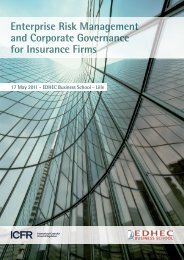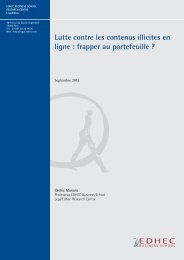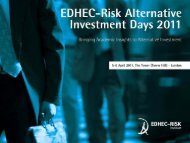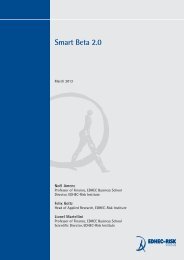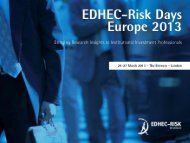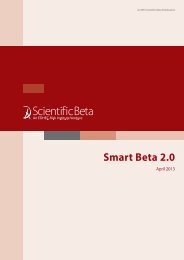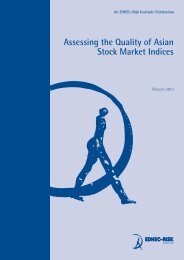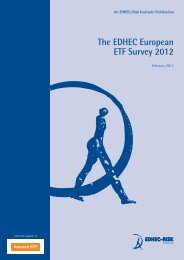You also want an ePaper? Increase the reach of your titles
YUMPU automatically turns print PDFs into web optimized ePapers that Google loves.
2. Research Chairs<br />
Currently eleven research chairs, associated with<br />
<strong>EDHEC</strong>-<strong>Risk</strong>’s six research programmes exploring<br />
interrelated aspects of asset allocation and risk<br />
management, are managed by <strong>EDHEC</strong>-<strong>Risk</strong> <strong>Institute</strong>.<br />
The research chairs involve close partnerships<br />
with their financial sponsors and a commitment<br />
from <strong>EDHEC</strong>-<strong>Risk</strong> to publishing related articles in<br />
international academic journals as well as to releasing<br />
the research results to the investment management<br />
profession through wide distribution of practitioneroriented<br />
publications and presentations at industry<br />
conferences. A selection of news concerning individual<br />
research chairs may be found below.<br />
Current Research Chair <strong>News</strong><br />
New research chair on Solvency II Benchmarks<br />
endowed by Russell Investments<br />
<strong>EDHEC</strong>-<strong>Risk</strong> <strong>Institute</strong> will be conducting research<br />
with the support of Russell Investments in order<br />
to design new benchmarks for European insurance<br />
companies that are representative of a dynamic<br />
allocation strategy between bonds and equities. The<br />
aim of the initiative is to enable all small- or mediumsized<br />
European insurance companies which do not<br />
have a full internal risk mitigation model to be able<br />
to avail of an objective academic reference in order to<br />
manage the risk of their equity investments.<br />
First year research project for Ontario Teachers’<br />
Pension Plan research chair underway<br />
Work has started on the first year research project<br />
of the Ontario Teachers’ Pension Plan “Advanced<br />
Investment Solutions for Liability Hedging for<br />
Inflation <strong>Risk</strong>“ research chair, under the supervision<br />
of Bernd Scherer, Professor of finance at <strong>EDHEC</strong><br />
Business School and member of <strong>EDHEC</strong>-<strong>Risk</strong> <strong>Institute</strong>.<br />
With $96.4 billion in net assets at December 31,<br />
2009, the Ontario Teachers’ Pension Plan is the<br />
largest single-profession pension plan in Canada.<br />
An independent organisation, it invests the pension<br />
fund’s assets and administers the pensions of 289,000<br />
active and retired teachers in Ontario.<br />
The theme of the first year research project is “Real<br />
Assets for Liability Relative Investors”. Industry wide<br />
pension funds all over the world tend to have made<br />
generous inflation indexed pension promises in the<br />
past. Given that real assets are often conjectured to<br />
offer a reduction in riskiness relative to a purchasing<br />
power metric, there is strong interest in the liability<br />
hedging properties of real assets. The conventional<br />
wisdom is that pension funds with real liabilities need<br />
to invest in assets that are positively correlated<br />
with inflation. As always, the conventional wisdom<br />
is incomplete. Pension funds with real liabilities<br />
need also to watch out for assets that are positively<br />
correlated with changes in real yields.<br />
The first year research will investigate the role of real<br />
assets for investors with real liabilities. While inflation<br />
and real rate sensitivities are both important and<br />
subject to the study, the ultimate question is whether<br />
real assets can help investors with real liabilities to<br />
improve the efficiency of their portfolios. The research<br />
will develop the necessary tools to investigate the role<br />
of real assets for pension funds with real liabilities.<br />
Latest findings from the Deutsche Bank and<br />
CACEIS research chairs reported recently in the<br />
Financial Times<br />
• Deutsche Bank “Asset-Liability Management<br />
Techniques for Sovereign Wealth Fund<br />
Management“ research chair<br />
In an article entitled “Sovereign wealth funds make<br />
presence felt” published in the FTfm on February<br />
21, Lionel Martellini, Scientific Director, and Vincent<br />
Milhau, Senior Research Engineer, at <strong>EDHEC</strong>-<strong>Risk</strong><br />
<strong>Institute</strong>, discuss the results of recent research<br />
conducted by <strong>EDHEC</strong>-<strong>Risk</strong> <strong>Institute</strong> as part of<br />
the Deutsche Bank “Asset-Liability Management<br />
Techniques for Sovereign Wealth Fund Management”<br />
research chair, which suggest that it is desirable to<br />
analyse the optimal investment policy of a sovereign<br />
wealth fund in an asset-liability management<br />
framework.<br />
The paper on which the article is based, “Asset-<br />
Liability Management Decisions for Sovereign<br />
Wealth Funds”, proposes a formal analysis of the<br />
optimal investment policy and risk management<br />
practices of sovereign wealth funds, which can be<br />
regarded as the extension to sovereign wealth funds<br />
of the liability-driven investing paradigm recently<br />
developed in the pension fund industry. This analysis<br />
has important potential implications in terms of<br />
the emergence of genuinely dedicated ALM and risk<br />
management solutions for sovereign wealth funds.<br />
<strong>EDHEC</strong>-<strong>Risk</strong> <strong>Institute</strong> <strong>Partner</strong> <strong>News</strong> - Issue nº 5 - April 2011 - 2




